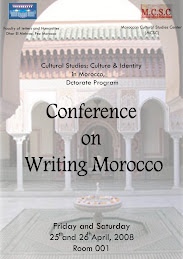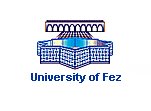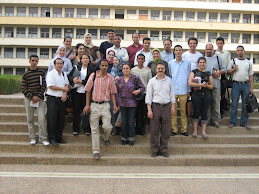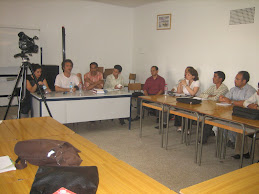Writing Morocco Conference: A Report
By Jamal Bahmad
Saturday, April 26, 2008.
The Moroccan Cultural Studies Centre at Sidi Mohammed Ben Abdellah University in Fez, Morocco, chaired by Dr. Khalid Bekkaoui, organized a two-day conference from April 25 to April26 which examined recent progress (and exploits!) in cultural studies research. Participation in the event included several of the Centre’s alumni and current doctoral students under the supervision of Dr. Bekkaoui and Dr. Fatima Mouaid. The avid participation of graduate students from current research programs at the university also made the event a success story. Throughout the six panels of the conference and a concluding roundtable, the audience was able to get acquainted with the imperatives and research questions driving the work of these young academics.
Friday, April 25, 2008.
The first day of the conference began with Dr. Bekkaoui’s address which shed light on the importance and urgency of such research encounters to the progress of the Moroccan tradition of cultural studies, something which the Center has always held as one of its foremost missions. In the same vein, he called upon the participants to continue their interests in interdisciplinary research on local questions in the context of recent developments in cultural theory scholarship worldwide. Dr. Bekkaoui, who is also a postdoctoral fellow at many British and American universities, concluded by promising the audience a rewarding experience by actively participating in this high-minded conference and future events of its kind.
Panel 1: Morocco through Travel and Captivity Writings
The first panel of the conference, chaired by Abdelmonaim Ouyidir, squarely addressed issues of representing Morocco in a number of cultural and literary works by Moroccan and European authors in the 19th and 20th centuries. The first speaker, Sakina El Khattabi, presented a paper on the intersections of race, gender and geopolitics in a selection of modern British women travel narratives on Tangier and Morocco at large. This first compelling presentation showed El Khattabi’s interests in elucidating the storied history of this Moroccan city which has always been a prominent contact zone in the itineraries of colonial and postcolonial discourses between Morocco and the rest of the Euro-American world.
The next participant, Mohammed Ahmed Gain, addressed similar concerns in the context of his research which focused on a number of influential Western travel accounts on Morocco in the modern period. Mr. Gain demonstrated to the conference audience the intricacies of the discourses of gender and nationalism in the formation of Western visions of Morocco since the beginnings of colonial Orientalism. He concluded his presentation by stressing the importance of seeing Orientalism as a heterogeneous set of discursive formations which speak volumes not only about the past of Moroccan-Western encounters in the framework of colonial and anti-colonial struggles and representations but also as one the residues of present-day media wars as is the case with the Hijab question in France and the rise of the discourses of Islamic terrorism, both secular and religious.
Nadia El Bouzouki’s paper tried to encourage the audience to look at the images of the Moroccan city in European women travel writing of the last two centuries. The speaker laid the ground for her intervention by stressing the travails of knowledge and power formations in the representation of this urban space ‘beyond the line,’ to put it in German political philosopher Karl Schmidt’s words. Ms. El Bouzouki delivered many of her research conclusions such as that the Moroccan city in the eyes of these female authors emerges as an agora of complex configurations of gender, space and race issues.
The first session of the morning panel was concluded by Layachi El Habouch’s paper. This researcher who specializes in modern Moroccan travel narratives about modern Europe invited the conference audience to challenge the categories of the Self and the Other in the context of one case study: Tahar al-Fassi’s al-Rihla al-Ibrizia ila al-Diyar al-Enghliziya. Mr. El Habouch framed his postcolonial approach by showing a keen interest in a textual analysis of a multitude of historical discourses which informed the images of the Self and the Other throughout the travel book of al-Fassi, once Moroccan ambassador to London. In an attempt to present a coherent vision of his subject matter, the speaker also endeavored to situate the authorship of the narrative in its dialogical historicity.
After a brief coffee pause, the audience were once again convened to attend the last three representations of the morning, which made up the Second Session of Panel 1. The first paper, “Moroccans in Drummond Hay’s Gaze,” was supposed to be given by Moundir El Amrani, a current PhD candidate in Dr. Bekkaoui’s doctoral program. Unfortunately, the participant himself was not able to make it to deliver his paper in front of an admirably enthusiastic audience of young researchers. Confronted with such a challenge, Panel Chairperson Mr. Ouyidir gave the audience a bird’s eye account of the research questions that this paper means to address in relation to Drummond Hay’s renditions of Morocco from his vantage point as a colonial officer.
Next speaker Majid Kettioui presented a paper on what he termed “the rhetoric of empire and its discontents” in the framework of his ongoing doctoral dissertation on questions of representation and power relations in British captivity narratives of the 17th, 18th and 20th centuries. This presentation started by putting the audience in the picture about the importance of tackling this subject, which has started to attract the attention of established postcolonial scholars such as Dr. Bekkaoui and Dr. Nabil Matar, to name but two. Mr. Kettioui then moved to acquaint the audience with the historical and intellectual contexts of a number of British narratives of captivity in Morocco. This research topic was further made appealing to a young audience, most in their early twenties, by drawing comparisons between these historical texts and today’s daily media accounts of the captivity of Western subjects in the Islamic world, a subject too familiar to the audience to shock them to develop a critical reception of mediated discourses of captivity, historically and now.
The last speaker of Panel 1 launched his intervention by promising the audience a critical take on the images of the Moor figure in modern British drama. His hugely performative approach struck a note with the discursive detours of stage representations. Mr. Jaouad Radouani inscribed his critique in the context of previous scholarship on the subject such as Dr. Bekkaoui’s Signs of Spectacular Resistance (1999). The speaker then presented a formalistic account of his subject matter by drawing on literary criticism only to move to a more challenging task: to extract the political and racial overtones of the representation of the Moor from the knotted literariness of some of the masterpieces of British drama since Shakespeare.
This first panel of the conference was round about by inviting the audience to share their commentaries and questions on different aspects of the research questions outlined in the panel’s presentations. Participation at this stage was arguably productive in both number and size. As the speakers were given time to respond to the reactions of the audience, it was dawning on every attendee that the conference was already a success story in the making.
Panel 2: Morocco through Diasporic Eyes
The second panel of the conference was oriented towards opening the space for the participant researchers and the audience to share exceptional excursions into the worlds of diaspora and its attendant promises and predicaments. As announced by Panel 2 chairperson, Mr. Kettioui, the two following presentations recommended themselves thanks to two invaluable assets: first, their scholarly rigor and bravura given the young age of postcolonial and cultural research in this area; second, the historical situatedness and urgency of this research for Moroccan cultural studies following the turbulent histories of the this country’s famous (e.g., Abdelkader Benali and Hollywoood’s Said Taghmaoui) and notorious (e.g., Mohammed Bouyiri and 9/11’s Zakaria Moussaoui) diasporic voices in Europe and the world at large.
After a short survey of some of the illustrious lines of debate in Diaspora Studies, first speaker Mimoun Daoudi confronted his topic head on by noting that his concern is with questions of memory and space-making in Moroccan-Dutch literature by taking as a case study H. Bouazza’s Abdullah’s Feet. The analytic scope of the paper was made even more concrete by elaborating on the terrains of ethnicity, realpolitik and the imaginary homelands in this novel. Mr. Daoudi kept the same rigor throughout his paper which revealed the rhizomANTics of identity formation in diasporic literature of the Moroccan-Dutch community, which has started to capture world attention in recent days due to the rise of serialized conservative voices both in the community and in the host society. Such recent cultural productions such as filmmaker Theo van Gogh’s 10-minute English language Submission (which triggered his slaughter by Moroccan–Dutch Mohammed Bouyiri), Moroccan-Dutch InterSection’s clarion rap songs, and Dutch pundit Geert Wilders' 15-minute movie Fitna are only some the harbingers of more creativity and anxiety of the hyphenated condition.
The next speaker of Panel 2, Mr. Lhoucain Simour, delivered a compelling presentation on the Moroccan-American Transatlantic. Taking as a starting point a widely held belief among Moroccan cultural studies practitioners that much work remains to be done to examine the flows of Transatlantic representations between U.S.-America and Morocco, the participant dwelt on questions of Otherness in Hijra ila Ardi Al-Ahlam (Migration to the Dreamland), a Moroccan academic’s account of his stay in the United States. Mr. Simour enticed the attention of the audience by foregrounding his approach as regards the heterogeneity of the Transatlantic representation as both a textual practice and “a mode of understanding.”
Panel 3: Morocco and War Veterans’ Narratives
With much dexterity, Mr. Simour switched his position from speaker in Panel 2 to moderator of Panel 3. This short panel addressed questions of memory and construction of Moroccanness and its Others through the oral narratives of native war vets during WWII, French Indochina wars and elsewhere. I should note here that this project’s value is double: the researchers were concerned with compiling an archive of oral narratives from living war veterans and then transcribe them for publication by the Moroccan Cultural Studies Centre Press, on the one hand, and with pioneering cultural research practices in the terrains of Moroccan war memories, on the other.
In this spirit first speaker, Fatima Kamal, tackled her subject matter by devoting a substantial part of her paper to questions of orality, memory and identity. This allowed her to pave the wave for a subsequent series of illuminations on key concerns in the study of identity and representation in war narratives. Further taking insights from different theories of narrative coupled with a sincere militant tone, Ms. Kamal dwelt on the affirmation of identity in the stories of these soldiers who were caught in a war machine which they had believed would emancipate them and their country from misery and colonialism. However, as they were to discover much later, they had been the object of an oblique betrayal by both colonizer and colonized-cum-postcolonial nation. In such a dreadful no man’s land, they had only one weapon to survive: narration.
Mr. Jawad El Alami, the next participant, shared with Ms. Kamal and the entire audience a concern with articulating the voices of resistance in the narratives of these forgotten warriors. First, the speaker related his insightful experiences with a dozen oral accounts which he had collected from the vets in their homes throughout Morocco. He then moved to specify that his critical stance concurs with Subaltern Studies scholarship. To substantiate this magnificent research project, Mr. El Alami started analyzing some of the key moments of narrativizing the past and the present in these war narratives.
Panel 4: Morocco in Media Discourses
After these two compelling presentations, Panel 4 was launched under the chairmanship of Mr. El Habouch, who stressed the importance of the theme to be broached by the last three speakers of the first day of the conference. The floor was thus given to Ms. Meriem El Amine who dealt with the constructions of gendered identities in a plethora of local and global media venues. Her overall focus was on questions of representing the female body in Moroccan and transnational magazines. Ms. El Amine took the continuity between colonialist and sexist discourses as her starting point. As a measure of concreteness, she displayed a number of still pictures that she argued evidence her critique of the styled sexism immanent in visual media’s renditions of the female body and, by extension, habitus.
Next speaker, Mr. Abdelali Jebar, introduced his paper as part of his PhD project dealing the representation of Fez in French and Moroccan colonial and post-colonial postcards. Mr. Jebar delivered an interactive talk much to his credit as part of the audience could not resist taking a siesta in the warm afternoon weather in Fez; after all, some of the figurants in the showcased postcards were winking at them that it was no harm doing so! But the speaker’s bursts of vivid analysis of each postcard convinced those audience attendees to postpone their naps to another day. Even Loti would not have had a different opinion!
Mr. Noureddine El Guennouni, the last speaker of the day, gave a presentation that took us all back to the pages of The Times of the late 19th century. The participant dealt with the intertwined discourses of trade and colonial desire in The Times’ coverage of a vulnerable Morocco falling prey to the major carnivorous colonial powers of the time: Great Britain and France. Mr. EL Guennouni therefore focused his analysis on the multifaceted ways in which this newspaper’s representations of Morocco were, in word and deed, geared towards making the case for the British throne’s would-be dominion in Morocco: a raj in Africa!
Before the curtains were drawn for the first day of the conference, an exhilarating open discussion was staged between the audience, who had already forgiven the speakers for having denied them a deserved siesta, and the participants. Questions, remarks and jokes were exchanged in a spirit and commitment known to young academics only.
Saturday, April 26, 2008.
Panel 5: Morocco: Tourism, Youth and Language
The conference community ardently convened for the second day of the event. It was now my turn to chair Panel 5 which addressed a wide range of research interests pertaining to modernity, tourism, youth subcultures and sociolinguistics. After a brief introduction to the major themes of the panel’s papers, I lent the floor to the first speaker, Wafae El Attaoui, who strived to introduce the audience to her research conclusions regarding the commingling of forces between modernity and the jargon and rituals of authenticity in the context of a Moroccan tradition of cultural tourism. Mrs. EL Attaoui ably deconstructed some of the languages structuring this tradition by drawing her examples from destination sites that she and the audience knew well. Her presentation, brief as it was, drew the audience’s attention to the challenges facing not only cultural tourism in Morocco and its thousand and one ways of museumizing the local but also the cultural studies critic in this regard.
Second participant, Mr. Ouyidir, delivered a lively talk on the history and cultural geographies of an emerging Moroccan youth subculture. His analysis lensed the practices and discourses of this multifaceted terrain, still less know to Moroccan academics thus far. He therefore started by drawing an extensive map of the different theories that have guided research in this area in American and European academies. With insights form Rupa Huq’s invaluable Beyond Subculture : Pop, Youth and Identity in a Postcolonial World (2006) and other high-caliber references, Mr. Ouyidir spent the rest of his paper endeavoring to articulate a postcolonial approach to different facets of youth subcultures in Morocco.
The floor was now moved to Mr. Abdelfattah Araq, who spent a good time probing the thorny dynamics of the Moroccan-Arabic system of address. His analytical paper drew its theoretical insights from functional linguistics and sociology to elucidate the diversity and pragmatics underlying Darija’s actual and virtual traditions of address. Mr. Abdelfattah delivered this lively talk in an interactive way that demonstrated his prowess in addressing — nay, seducing— an audience for whom Moroccan-Arabic or its twin Tamazight is the mother tongue so much so that I had really exhausted all my repository of address-systems trying to make him keep his talk to the clock.
Panel 6: Screening Morocco
The last panel of the two-day conference was devoted to the cinematic. Sternly, but marvelously, moderated by Ms. EL Amine, Panel 6 began with an introduction in which she informed the audience about the crucial importance of the two research papers dealing with different dimensions of the (trans)national Moroccan cinematic event.
It was now my turn to address an audience with a keen interest in divulging the mysteries of this understudied cinema. My paper was squarely concerned with bringing Deleuzian film-philosophy to bear on postcolonial film theory in an effort to trace a manifold thesis about the subject in Moroccan film beyond the ‘State science’ of representation. With this ambitious aim in light, I endeavored in the first place to acquaint the audience with the importance, if not indispensability, of a Deleuzian filmosophy of difference encountering Moroccan cinema. Following this brief exploit, I was systematically keen on stressing the point that my ‘minoritarian’ approach will not follow the dominant, if not domineering, paradigm in postcolonial film theory by approaching the cinematic event a matter of “preconstituted images” of a conflict between the representationlist polarities of modernity and tradition. Crucially, I strived to work out my point that the subject in Moroccan film is a virtual field that actualizes in intensive schemes of duration, vortical diagrams of embodiment AND the becoming-other of the national subject. This was my wager. To make the point even clearer, I marshaled a cogent array of concepts, percepts and affects at the core of a postcolonial Deleuzian filmosophy of difference. After some incursions into exploring a couple of Moroccan films, my ‘nomad science’ approach concluded by putting a particular emphasis on the urgency of constructing a “pedagogy of the concept” (Deleuze), a new heretical pragmatics of concept-building for cultural studies research in Morocco to take it beyond the ‘royal science’ of representation and its attendant arborescent Platonisms.
Last speaker, Mrs. Bouchra Badaoui, delivered her vital paper by dwelling on a close textual analysis of a selection of films of the early Moroccan cinema. Her approach borrowed insights from established (Kantian) traditions in film analysis, postcolonial theory and cultural studies. Mrs. Badaoui challenged the audience to keep a critical eye on the discursive imbrications of meaning-making in the Moroccan cinema of the masters: Hamid Bennani, Abderahmane Tazi, to cite but two. She showed how meaning-making in their films is a storied poetico-perfomativity that transcends the sublime dynamics of their contingent environment within the filmic space. In a next level, she deployed the category of space to unravel the rich textiles of every film whose meaning-making she endeavored to unlock to the audience.
After these two papers which had strived to deliver divergent critiques of the Moroccan cinematic event, the audience was eagerly invited to engage all the participants of the second day’s panels. The ensuing debates proved insightful to both speakers and discussants.
Roundtable
The conference was concluded by a final roundtable chaired by Dr. Bekkaoui and Dr. Mouaid, the organizers of the event. In their speeches, both professors encouraged the participants to continue to further research each in his/her research area and to collaborate in finalizing their conference papers’ findings for publication in a special issue of the Centre’s journal. This roundtable was also an occasion for both participants and audience to outline the achievements and gaps (time, of course!). All in all, everybody agreed that the next conference would be an occasion to foster the achievements and go beyond the gaps.
Prayer
After their excellent performance in mesmerizing the conference audience, the participants said farewell to each other and hastily murmured that they would see each other again soon: same place, same zeal. They embraced, scattered and then rode magic carpets to their far abodes in Absurdistan thus answering the call of mystical powers from One Thousand and One Nights.
Let’s pray the magicians of the Orient will bring these indispensable voices together again next November for another encounter before the last. An encounter “after the fact.” Amen!



